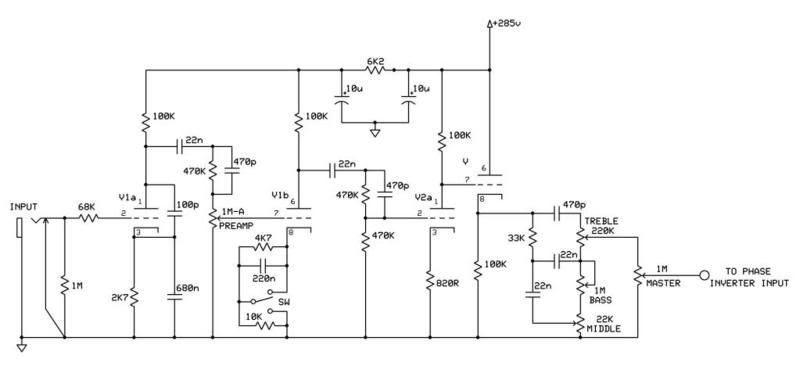So I wired up an amp with the following schematic:
http://home.westman.wave.ca/~vwtweak...uly10%20jp.jpg
I took the presence control from an old 5f6a schematic I found (I used a bigger pot though). The nfb is wired into the tone stack rather than one of the previous preamp stages, which I haven't seen done very often, but I didn't have a stage in the preamp after the tonestack but before the PI so it seemed like the place to tie it into.
It definitely affects the sound, but almost seems like an extension of the mid control.. Seems to act like a scoop control, or something like that, not really like I expected a presence control to act.
I'm not saying I mind what it does, it's an interesting control to have on the amp, but I would probably prefer having a more traditional control over presence.
What is this control actually doing? (sorry the theory behind this type of thing is not one of my strong points).
And secondly, is there a better location that I could tie this into?
I appreciate any help on the matter.
Thanks.
http://home.westman.wave.ca/~vwtweak...uly10%20jp.jpg
I took the presence control from an old 5f6a schematic I found (I used a bigger pot though). The nfb is wired into the tone stack rather than one of the previous preamp stages, which I haven't seen done very often, but I didn't have a stage in the preamp after the tonestack but before the PI so it seemed like the place to tie it into.
It definitely affects the sound, but almost seems like an extension of the mid control.. Seems to act like a scoop control, or something like that, not really like I expected a presence control to act.
I'm not saying I mind what it does, it's an interesting control to have on the amp, but I would probably prefer having a more traditional control over presence.
What is this control actually doing? (sorry the theory behind this type of thing is not one of my strong points).
And secondly, is there a better location that I could tie this into?
I appreciate any help on the matter.
Thanks.


Comment